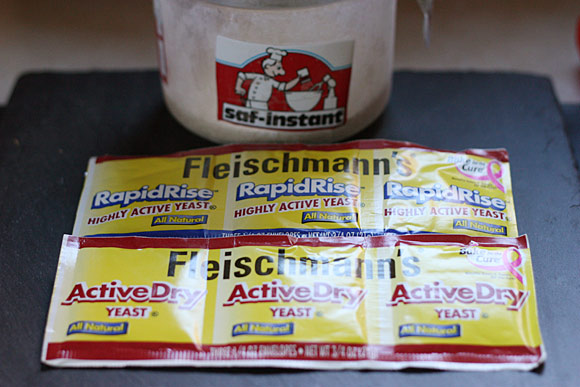Learn all about the different types of yeast used by bakers to create wonderfully textured breads and baked goods. Also includes tips for selecting and storing yeast.

If there was ever a culinary ingredient that could strike paralyzing fear into the hearts of so many desperate to embrace it, it’s yeast.
Yeast and I go way back. Waaaay back. Yeast bread was, in fact, the very first thing I ever baked completely from scratch. Not kidding. Cinnamon swirl bread, to be exact.
No easy-peasy chocolate chip cookies for me, no sir. When SoupAddict decides to try something, she dives in head first, aallll the way. Yeast bread, right out of the gate. I still chuckle at the bravado of it — who chooses yeast bread as their very first [non-box-mix] baking project?
Anyway. The result was … awesome. Know why? Because I was such a bottom-rung beginner, I followed the recipe instructions to a painstaking “T”. And that included the handling of the yeast. It was an accidental lesson I wish I had actually recognized as a lesson to be absorbed, because it would’ve saved a few head-scratching failures later.
With proper handling and care, yeast is your friend. And absolutely nothing to fear. Just don’t kill it.

That’s right. I said, don’t kill it. Yeast is a living thing, vulnerable to mishandling and abuse. But, it’s also fairly low maintenance. Store it properly, and don’t overheat it during proofing, and you’ll be BFForevah.
Types of yeast
I know. It can be confusing, standing in the baking aisle, wondering which yeast to buy, especially with the odd jargon used to label it. Here’s the scoop on the various types available.
Active dry yeast: active dry yeast is desiccated, granulated and milled before packaging, and needs to be re-activated by soaking it in lukewarm water (90°F to 100°F), often with a pinch of sugar to feed the hungry, awakening microbes, before adding it to the remaining ingredients. (Also known as “proofing.”)
Instant dry yeast: compressed and more finely-milled than active dry — and therefore a little more potent — instant dry does not need to be proofed and can be added directly to your recipe with the other dry ingredients. Most of the bread recipes you’ll find here on SoupAddict use instant dry yeast. (I buy the SAF brand in a one-pound brick, and store it in the freezer.)
Bread machine yeast: this is essentially instant dry yeast. I wouldn’t bother using it unless you exclusively use a bread machine and only recipes that call specifically for it. Instant dry yeast will work just fine in your bread machine.
Fresh yeast: as the name correctly implies, this yeast is fresh, not desiccated, and comes in cubes at the grocery store. Fresh yeast is often the go-to yeast for commercial bakers, but not entirely ideal for the casual home baker as it has a scant two-week shelf life.
“Rapid rise” or “quick rise” yeast: this is meant for recipes with fairly short rise times, skipping one of the two standard yeast dough rises — say, “pizza dough in 30 minutes” kind of recipes. If you’re in to making highly flavorful loaves of bread with long, slow rise times, I would choose another yeast, as you’re not going to get that wonderful yeasty, homebaked flavor from this type.
Wild yeast: more of a fun project than a practical ingredient, starter doughs can usually be created, even in your home, without the direct addition of commercial yeast. Yeast is present in the air in most environments, and with a little patience, you can take advantage of that naturally occurring yeast by leaving your starter dough out on the counter to “absorb” yeast from the air. Ready to try it? I’ve got just the wild yeast sourdough starter project for you!
Summary: active, instant and fresh will all give similar results in that they’re made for recipes requiring two separate long rises, as is the standard in yeast dough recipes. Fresh is harder to come by and somewhat inconvenient with its short shelf-life (although the die-hard following of fresh yeast users claim it’s worth it).
For the average baker, you can’t go wrong with either active dry or instant dry. Rapid or quick rise is only for special recipes taking short-cuts around the long rises. (Although rapid or quick rise will leaven your dough to some degree no matter the recipe, you won’t get that fabulous yeast bread flavor from it, since all the yeastly activity happens very quickly and then stops, whereas active, instant and fresh continue contributing flavor and character for the entire rise, whether one hour or one day.)
Switching between active and instant
You can substitute active for instant, and vice versa, in any recipe. The key is the proofing (or lack of) and the liquid adjustments.
Yeast quantities and proofing: Instant yeast is more potent than active, so if using active instead of instant, add about 25% more active yeast (and add a proofing step if the recipe doesn’t call for one). If using instant instead of active, decrease the yeast by about 25% (don’t sweat the exact amounts — it’ll be okay!), and add it directly to your dry ingredients without proofing.
Liquid adjustments: When using instant instead of active, make sure you add the same amount of liquid called for in proofing the active yeast to your recipe. (So, if the recipe calls for proofing active yeast in a 1/2 cup of water, but you’re using instant yeast, make sure you add that 1/2 cup of water along with your other liquids.) And in the opposite direction, if you’re using active instead of instant, borrow a 1/2 cup of liquid from the total liquids called for to proof active yeast.
Buying yeast
Just one word about buying yeast: if you plan to make yeast dough with any sort of a frequency (even once a month), I can’t recommend buying those little foil packets. They’re insanely expensive compared to buying a jar or a one-pound brick of instant yeast. Yeast will store for at least a year, so even if you make just four recipes in that one year stretch, you will save money.
It’s not a yeast-quality issue, it’s strictly dollars and sense (I mean, cents). To wit: a $6 one-pound brick of instant yeast will make almost 100 loaves of bread. A $3 strip containing (3) quarter-ounce foil packets will make about 6 loaves of bread. You do the math.
How to not kill yeast
It’s simple, really. Store it properly (below). And don’t ever use really hot water in your recipes.
I had several (ahem, many) failures as a young bread baker because I thought that if lukewarm water was good (for proofing), boiling water had to be even better! Yup, I’ve killed my fair share of yeast [hangs head in shame].
Note that lukewarm water is between 90°F and 100°F. Also note that the hot water coming out of the average home faucet is around 125°F — still too hot. If you’re serious about bread baking, invest in a good instant read thermometer and always, always take the temperature of your water before either proofing active dry yeast, or adding to your recipes using instant dry yeast.
Storing yeast
When stored properly, dry yeast almost always exceeds its expiration date. Store active, instant and rapid/quick rise in air-tight containers in the refrigerator or freezer. No need to bring to room temp or thaw before use. Fresh should always be stored according to the package directions and discarded after its expiration date.
Happy Baking, my fellow bread-bakers!


Tony P
Thursday 10th of November 2011
My favorite use for it is cibatta bread. It's got a LONG rise time, 18+ hours but the result, I love it.
yummychunklet
Thursday 10th of November 2011
I finally got the hang of yeast (by not killing it!) with proper temperature water and a bit of honey in the mix. Great and informative post!
Noelle
Thursday 10th of November 2011
This is a kick-bum primer. I have to say, I've shied away from baking bread because of...shame...fear of yeast. It always seemed like there was way too much room for error. I can't even tell you the money I've wasted buying those little packets of yeast (gulp!), and then NOT USING THEM cause I started doubting myself. I love to bake, but I love to cook more, only because I feel like I'm less restricted when cooking. Baking must be precise.
However, I have to thank you for dumbing down yeast without making me feel, well, dumb. I feel a new-found surge of confidence. Perhaps this weekend will bring the smell of a freshly baked loaf of yummy goodness...
Cher
Thursday 10th of November 2011
Good primer! I (heart) yeast. SAF Regular & Gold are "like totally" my two favorites and have a permanent home in my freezer door (although, I abashedly admit I have a pound of Fleischmann's sitting in my freezer too that I picked up at a wholesaler during the midst of a yeast emergency & couldn't bring myself to not use once I owned it. There, I said it, I am a yeast hoarder...)
SoupAddict
Thursday 10th of November 2011
LOL! Yes, that's my SAF regular container in the top picture (still frosty from the freezer ... and nearly empty). It sits right next to the container of Gold. I found the packets of yeast at the bottom of the tub where I store my extracts and stuff, years out of date. I don't even know what's up with the strip of rapid rise - I've never used it. I must've had a Mother of SoupAddict moment — she was known for accidentally grabbing Diet Mt. Dew off the store shelf back in the days when us kids would drink nothing but the high-octane version.